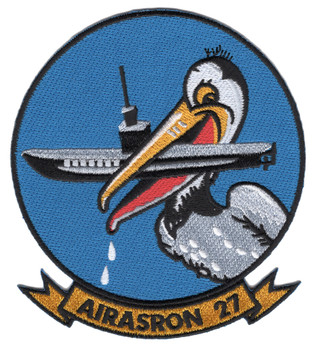Description
VS-73 Aviation Anti-Submarine Squadron Patch (U.S. Navy) 4.5" x 4.5" Embroidered Patch with Sew-On Backing
Superior Materials: Made with premium polyester thread and durable twill fabric, ensuring long-lasting color and strength.
Advanced Embroidery Technology: Crafted using the most advanced embroidery machinery, guaranteeing intricate detail, sharp lines, and consistent quality every time.
Easy Iron-On Application: Features a heat-activated adhesive backing for quick, no-sew attachment. Simply position, iron, and press for a secure bond.
Versatile Use: Perfect for personalizing jackets, backpacks, uniforms, or any fabric surface that needs a touch of personality.
Durable and Washable: Designed to withstand everyday wear and occasional washing without fading or fraying.
Formations & Origins
Air Anti-Submarine Squadron 73 (VS-73) was a United States Navy squadron formed in the early Cold War period to address the growing threat of enemy submarines, particularly from the Soviet Union. Established to provide specialized anti-submarine warfare (ASW) capabilities, VS-73 was part of the Navy’s broader effort to protect carrier battle groups and vital maritime shipping lanes from underwater threats. The squadron operated as an essential element of the Navy’s airborne ASW forces, combining advanced sensors and weapons with rigorous training to maintain maritime dominance.
Notable Commanders
VS-73 was led by a succession of capable commanders skilled in both aviation and ASW tactics. Their leadership was critical in shaping the squadron’s tactical doctrine and ensuring the crew’s proficiency in submarine detection and engagement. Commanders emphasized innovation and adaptability, qualities necessary to keep pace with rapidly evolving undersea warfare technology and tactics.
Major Campaigns/Operations
VS-73 played an active role throughout the Cold War, participating in numerous fleet exercises designed to counter Soviet submarine incursions. The squadron deployed aboard aircraft carriers and operated from shore bases to conduct patrols and training missions that sharpened its ASW capabilities. VS-73’s operations contributed to the containment strategy aimed at denying Soviet submarines access to critical sea lanes and striking power projection. While the squadron did not see combat in wartime, its continuous vigilance and readiness were a vital deterrent against undersea threats.
Specialized Role/Equipment
VS-73 specialized in carrier-based anti-submarine warfare, flying aircraft such as the Grumman S-2 Tracker and later the Lockheed S-3 Viking. These aircraft were equipped with sophisticated sensors, including sonar buoys, magnetic anomaly detectors, and radar systems, enabling the squadron to locate and track submerged submarines. Armed with torpedoes and depth charges, VS-73’s aircraft were capable of engaging enemy submarines effectively, supporting fleet defense and maritime patrol missions.
Acts of Heroism
Although VS-73 did not engage in direct combat, the squadron’s personnel demonstrated constant professionalism and courage in performing demanding ASW missions. Crews regularly operated in challenging environments—often flying low over open ocean, in poor weather, and under the pressure of simulated or real potential submarine threats. The precision and teamwork required to execute ASW operations safely and effectively reflected a quiet but vital heroism essential to naval security.
Legacy & Notable Achievements
VS-73’s legacy is deeply tied to the evolution of naval anti-submarine warfare during the Cold War. The squadron helped develop and refine tactics and technologies that became standards in ASW operations. By maintaining a high state of readiness and operating some of the Navy’s most advanced ASW aircraft, VS-73 contributed significantly to the security of carrier groups and maritime commerce. The squadron’s dedication to its mission ensured that U.S. naval forces maintained undersea superiority throughout a critical period of strategic competition.






